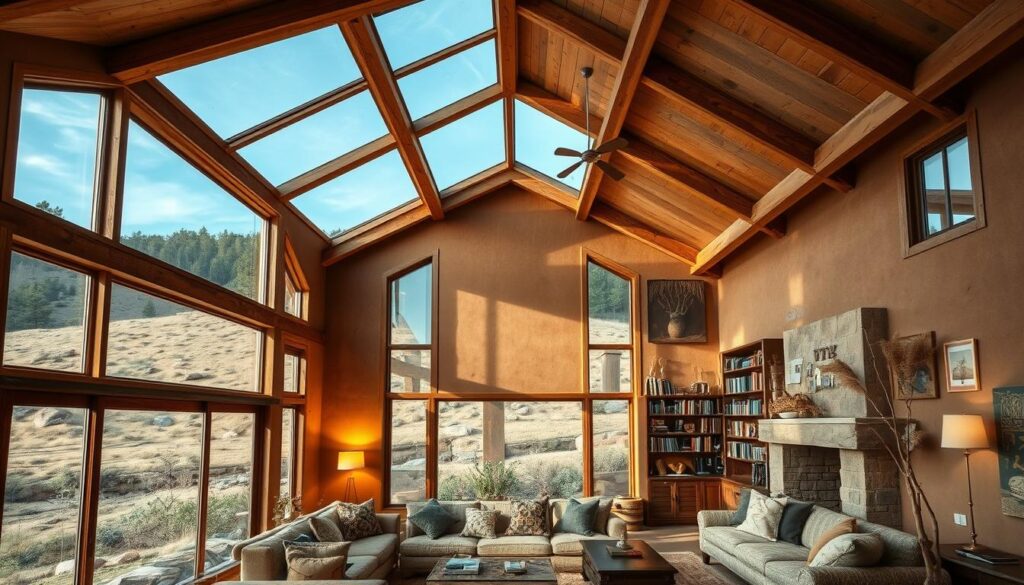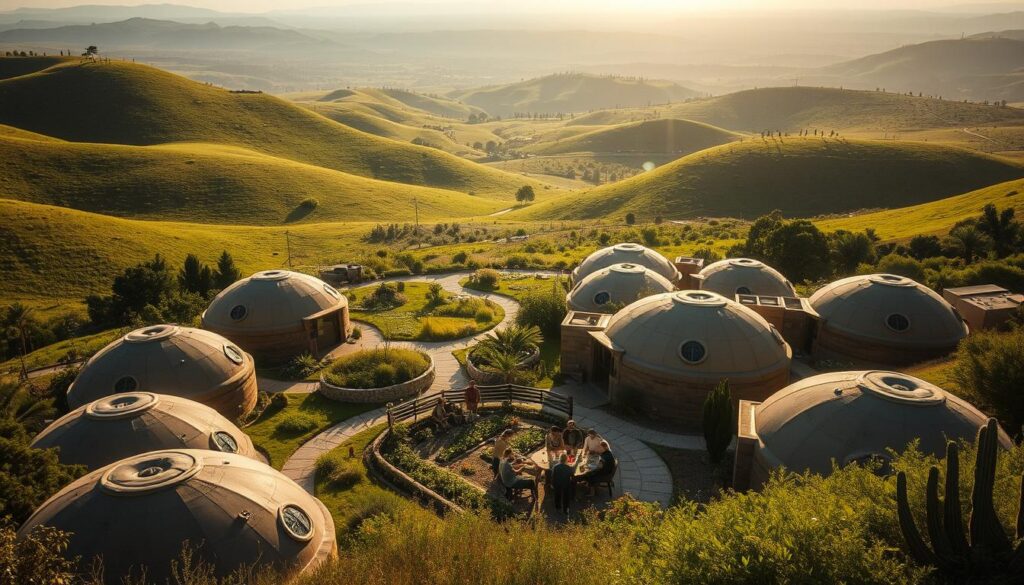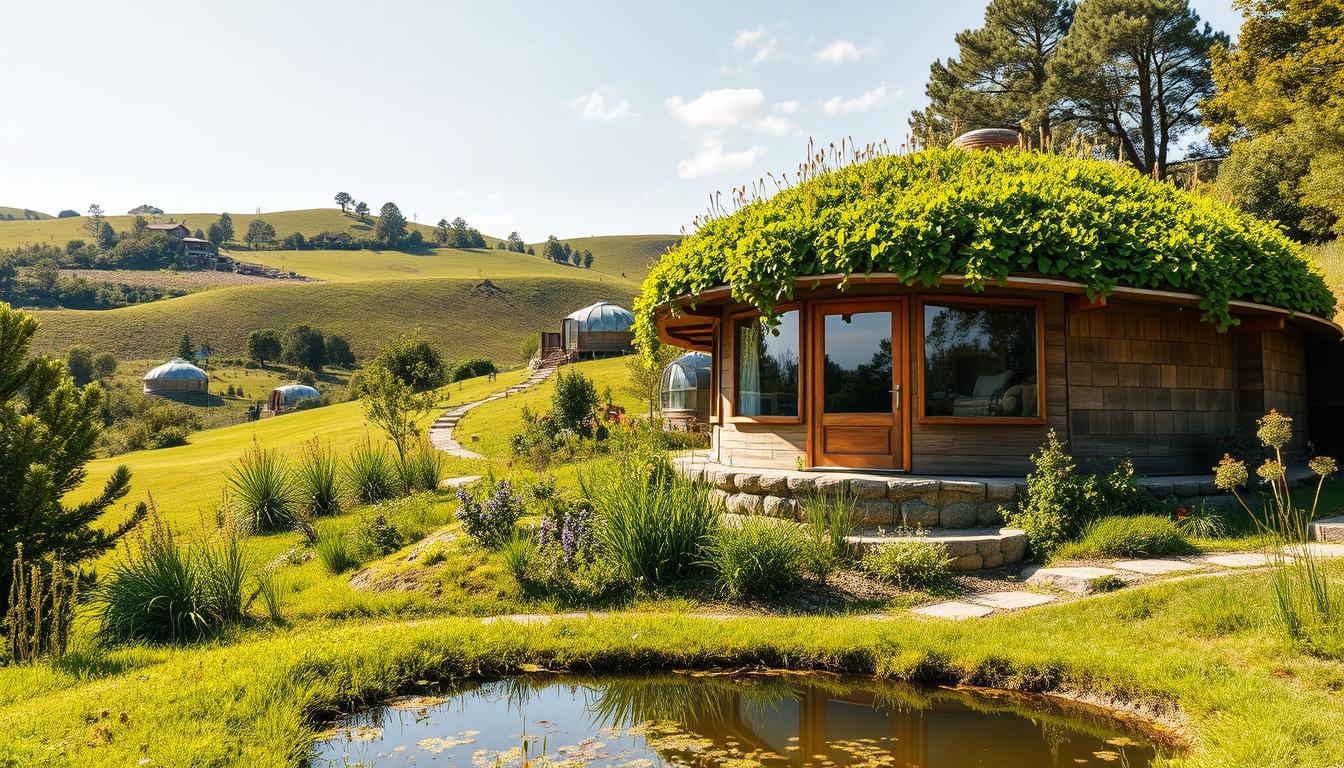Did you know over 100,000 people worldwide live in Earthship homes? They live off the grid and are kind to the planet. These homes use renewable energy sources and recycled materials to cut down on waste.
There’s a big move towards sustainable living, and Earthship homes lead the way. They make living greener by using sustainable practices in daily life. This helps reduce waste and makes homes healthier for those who live there.
Looking into Earthship homes, we see they’re a special choice for those wanting to live sustainably. They focus on using renewable energy and recycled materials. This makes them a great pick for people who care about the environment.
Key Takeaways
- Earthship homes are designed to be self-sufficient and off-grid.
- They utilize renewable energy sources and recycled materials.
- Sustainable living is a core principle of Earthship homes.
- These homes minimize environmental footprint and promote healthier living.
- Earthship homes are an attractive option for environmentally conscious individuals.
What Are Earthship Homes and Their Origins?
Earthship homes have a rich history and focus on being green and self-sufficient. Architect Michael Reynolds started this movement in the 1970s. These homes follow six key principles, like using the sun for heating and cooling, and collecting rainwater.
The Concept of Earthship Design
Earthship design uses recycled materials like tires and cans. This cuts down on waste and helps the environment. The homes are built underground for natural insulation and to protect against harsh weather.
They also rely on renewable energy like solar and wind power. This reduces the need for energy that harms the planet.
Historical Development in Sustainable Architecture
The 1970s marked a big change towards green design. Michael Reynolds led the way with his use of recycled materials and renewable energy. His work set the stage for today’s sustainable architecture.
Some important moments in Earthship history include:
- The first Earthship homes were built in the 1970s in New Mexico.
- In the 1990s and 2000s, Earthship communities started popping up all over the world.
- Now, Earthship homes inspire people everywhere to live more sustainably.
Key Innovations in Earthship Construction
Earthship construction is full of creative solutions. They use tire walls for strength and to keep warm, and can walls for extra space. They also have smart systems for collecting and using rainwater.
The main innovations in Earthship building are:
- Building with recycled materials.
- Using renewable energy sources.
- Creating efficient water systems.
Key Features of Interior Earthship Homes
Inside an Earthship home, you’ll find a mix of natural materials and smart, green solutions. These homes are not just beautiful but also work well, saving energy and being kind to the planet.
Natural Building Materials Used
Earthship interiors stand out because of their use of natural and recycled materials. Recycled materials like reclaimed wood, tires, and cans are good for the environment and make the home special. They’re used in walls, floors, and decorations, making the space cozy and welcoming.
The homes also use natural insulation like earthbags or rammed earth. This helps keep the temperature inside steady.
Sustainable Energy Solutions
Earthship homes are built to save energy. They use sustainable energy solutions like solar, wind, and hydro power. The layout is designed to let in lots of natural light, cutting down on the need for artificial light. Energy-efficient appliances and lights also help save energy.
Water Harvesting and Management Systems
Earthship homes are great at saving and using water wisely. Rainwater harvesting systems collect and store rainwater for drinking, cooking, and watering plants. Greywater systems reuse water from sinks, showers, and washing machines, reducing water waste.
Temperature Regulation Techniques
Earthship homes keep a comfortable temperature without needing a lot of outside energy. This is thanks to passive solar design, thermal mass, and insulation. The homes’ earth-sheltered design also helps keep the inside cool in summer and warm in winter.
These features make Earthship homes a green, off-grid living option that’s both eco-friendly and cozy.
Benefits of Living in Earthship Homes
Earthship homes offer many benefits, like being good for the environment and improving your life. They are built to be self-sufficient. This means they use green building techniques to reduce harm to the planet.
Environmental Advantages
Earthship homes are great for the planet. Their eco-friendly design uses recycled materials and makes its own energy. This cuts down on the need for public utilities and lowers carbon emissions.
- Reduced carbon footprint through renewable energy systems
- Utilization of recycled and natural materials in construction
- Efficient water harvesting and management systems
Cost Savings Over Time
Earthship homes save money in the long run. They are affordable to build and maintain. Plus, using sustainable living practices and renewable energy can save a lot of money.
- Lower utility bills due to self-generated energy and water conservation
- Minimal maintenance costs thanks to durable, natural building materials
- Potential for selling excess energy back to the grid
Enhanced Quality of Life
Living in an Earthship home can make your life better. It provides a healthy, sustainable place to live. The connection to nature and feeling self-sufficient can boost your well-being.
- Improved indoor air quality through natural ventilation systems
- A stronger sense of community through shared resources and knowledge
- A healthier lifestyle promoted by the home’s design and surroundings
Connection to Nature
Earthship homes are built to fit into their surroundings. This creates a strong connection to nature. It makes living there more peaceful and fulfilling.
By living in harmony with nature, Earthship home residents enjoy a better, more sustainable life.
Designing Your Own Earthship Home
Designing your own Earthship home starts with understanding your site. You need to analyze your site’s climate, topography, and natural resources. This is the first step.

Understanding Your Site’s Unique Needs
Knowing your site’s conditions is key for a sustainable and comfy Earthship home. Sunlight, wind, and soil quality are important. For example, the local climate helps design passive solar heating and cooling systems, essential for Earthship homes.
The land’s shape also affects your home’s design. A sloping site might need extra work for a stable base. A flat site offers design flexibility.
Customization Options for Interiors
Earthship homes are great for personalizing your space. You can pick from natural and recycled materials to match your style. Materials like earthbags and reclaimed wood are eco-friendly and add character.
Also, you can design your home’s layout to fit your lifestyle. Whether you want an open area or separate rooms, it’s up to you. This makes your home both functional and cozy.
Collaborating with Earthship Architects
While DIY is rewarding, working with Earthship architects can improve your project. They know a lot about sustainable design and off-grid homes. This ensures your home looks good and is eco-friendly.
Architects for Earthship homes offer valuable insights. They know about local building codes and climate-specific designs. Their help can make your home meet your needs and support sustainable living.
Challenges in Building Earthship Homes
Building Earthship homes is a sustainable living solution, but it comes with challenges. We face legal, regulatory, and social hurdles. It’s key to understand these obstacles.
Legal and Zoning Issues
One big challenge is dealing with legal and zoning rules. Many places have rules that don’t fit Earthship homes. We need to work with local authorities to follow these rules, which might mean getting special permits.
Building Codes and Permits
Getting permits for an Earthship home is tough. Building codes usually favor traditional homes, not eco-friendly ones. By working with local officials and showing detailed plans, we can get the permits needed.
Community Acceptance and Perception
Getting the community to accept an Earthship home is important. Some might not like the look or the use of recycled materials. By teaching them about green building techniques and eco-friendly design, we can win them over.
By tackling these challenges, we can build Earthship homes that are good for the planet. These homes will make our community more sustainable and resilient. Living sustainably means creating homes that are better for us and the environment.
The Role of Community in Earthship Living
As we move towards more sustainable living, Earthship communities are leading the way. These communities are more than just homes. They are places where people live together, working towards a greener future.

Examples of Earthship Communities in the U.S.
In the U.S., many Earthship communities are thriving. Each one has its own special way of living sustainably. For example, the Earthship Community in Taos, New Mexico, is famous for blending homes into a community.
Communities in Colorado and Oregon are also making waves. They show us how to live in tune with nature. These places are proof that Earthship homes can work well together.
Sharing Resources and Expertise
Living in an Earthship community means you can share and learn from others. People work together on projects and share tips on green living. This teamwork makes homes more sustainable and strengthens community bonds.
For instance, folks might pool their tools, cutting down on waste. They also host workshops on green topics like solar power and organic gardening. This sharing of knowledge helps everyone grow and learn together.
Creating a Sustainable Lifestyle Together
Earthship communities aim to create a lifestyle that’s good for the planet. By living together, people can achieve big goals like lowering carbon emissions and saving water. It’s a team effort to make a difference.
Communities can tackle big projects like shared gardens and renewable energy systems. This teamwork not only helps the environment but also makes life better for everyone. It builds a strong, supportive community.
Financing an Earthship Home: What to Know
Earthship homes are becoming more popular. This means we need new ways to finance them that support green building.
Getting a loan for an Earthship home involves a few steps. First, you need to know the estimated costs of construction. Then, look for grants and incentives. And don’t forget about other financing options.
Estimated Costs of Construction
The cost to build an Earthship home varies. It depends on where you are, how big it is, and how complex the design. On average, it costs between $50 to $150 per square foot. This is similar to the cost of traditional homes in many places.
Remember, the cost isn’t just for building. Earthship homes also save money on utilities and upkeep. This is because of their eco-friendly design and sustainable energy solutions.
Grants and Incentives for Sustainable Living
There are grants from governments and private groups for sustainable homes, like Earthships. These can help lower the upfront costs.
- Energy-efficient mortgage programs
- Renewable energy tax credits
- Grants for sustainable building materials
It’s a good idea to look into local, state, and federal incentives. They can make your Earthship home more affordable.
Crowdfunding and Community Investments
If traditional loans aren’t an option, crowdfunding and community investments are good alternatives. They not only raise funds but also create a community around your project.
Use platforms like Kickstarter, Indiegogo, and local fundraising to support your Earthship project. This promotes sustainable living and brings people together.
Earthship Homes and Climate Resilience
Earthship homes are a promising solution for living sustainably. They are designed to handle climate change challenges. Their unique features make them ideal for resilient living.
Coping with Extreme Weather Conditions
Earthship homes can face extreme weather head-on. They use natural and recycled materials for insulation. This keeps the inside cool in summer and warm in winter.
Their design also includes energy-efficient systems. This helps maintain a comfortable living space, no matter the weather outside.
For example, thick walls protect against strong winds and debris. Using sustainable practices in building makes Earthships more resilient to disasters.
Lessons from Climate Studies and Earthship Implementation
Climate studies show the need for sustainable homes. Earthship homes are a model for climate adaptation. They focus on sustainable living and off-grid housing.
Earthships have been tested in different climates worldwide. They’ve shown how to adapt to various conditions. For instance, those in New Mexico thrive in dry conditions.
“Earthship homes are a big step towards sustainable living. They use natural materials and reduce our environmental impact. This helps us deal with climate change better.”
Sustainable Practices that Enhance Resilience
Earthship homes use several sustainable practices. These practices make them more resilient. Here are some examples:
- Rainwater harvesting and greywater reuse systems reduce water use.
- Renewable energy sources like solar and wind power provide electricity.
- Organic gardening and food production ensure a sustainable food supply.
| Sustainable Practice | Benefit |
|---|---|
| Rainwater Harvesting | Reduces water bills and dependence on municipal supplies |
| Renewable Energy | Lowers energy costs and reliance on fossil fuels |
| Organic Gardening | Provides a sustainable food source and enhances food security |
These practices make Earthship homes sustainable. They also help their inhabitants face climate change better.
Maintenance of Earthship Homes: Keeping it Sustainable
Earthship homes are built with eco-friendly design and green building techniques. They need special care to stay sustainable. We’ll look at routine maintenance, long-term tips, and upgrading systems over time.
Routine Maintenance Practices
Keeping Earthship homes in good shape is key. This includes:
- Checking and maintaining the water harvesting and filtration systems to ensure clean water supply.
- Inspecting the renewable energy systems, such as solar and wind power, to maximize energy production.
- Ensuring that the natural and recycled building materials remain in good condition, repairing or replacing as necessary.
Michael Reynolds, the pioneer of Earthship architecture, said, “The home is not just a shelter; it’s a living system that needs care and attention.”
“A true Earthship is not just a house; it’s a self-contained ecosystem that works in harmony with the environment.”
Long-term Sustainability Tips
To keep Earthship homes sustainable for a long time, consider these tips:
| Practice | Benefit |
|---|---|
| Regularly inspecting and maintaining insulation | Reduces energy consumption and maintains internal temperature stability |
| Using sustainable and locally sourced materials for repairs and upgrades | Minimizes environmental impact and supports local economy |
| Implementing waste reduction and recycling practices | Decreases waste sent to landfills and conserves resources |
Upgrading Systems Over Time
As technology gets better, Earthship homeowners might need to update their systems. This could mean:
- Upgrading to more efficient solar panels or energy storage systems.
- Improving water harvesting and filtration systems for better water quality.
- Incorporating new sustainable technologies as they become available.
By being proactive with maintenance and adopting new tech, Earthship homeowners can keep their homes sustainable and efficient for years.
Resources for Earthship Enthusiasts
Exploring Earthship homes opens up a world of sustainable living and off-grid housing. There’s a lot of information out there for those eager to learn. Many resources offer valuable insights and guidance.
Literature and Visual Resources
Books and documentaries dive deep into Earthship living. They show the benefits of sustainable homes. These resources are great for learning about Earthship design and building.
Communities and Networks
Online communities and organizations are full of Earthship enthusiasts. They offer forums for discussion and advice. These networks are perfect for those starting their own Earthship projects, connecting with others who share their passion.
Hands-on Learning Opportunities
Workshops and events across the country provide hands-on learning. Participants can learn practical skills in building and maintaining Earthships. These events are great for networking and learning more about sustainable homes.



